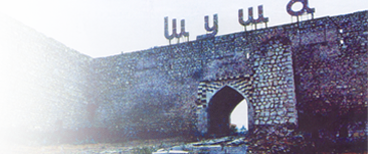 This Azerbaijani region was occupied by the Armenians 15 years ago. The area of Jabrail is 105 thousand hectares. Jabrail is an ancient Azerbaijani region located in south-west of the country and divided from Iran by the Araz river. This is one of the most beautiful place of Azerbaijan rich in historical, architectural and natural monuments including the Khudaferin Bridges that date back to XI century “Gyz galasy” (the Maiden Tower) (XII-XIV centuries), “Gala burju” (Constellation Tower) (V-VI centuries), burial mound in the territory of Dag Tumas village, bath-house Sultan Majid (middle ages), many mausoleums, Khan-Chinar-a tree at the age of more that 800. Etc.
This Azerbaijani region was occupied by the Armenians 15 years ago. The area of Jabrail is 105 thousand hectares. Jabrail is an ancient Azerbaijani region located in south-west of the country and divided from Iran by the Araz river. This is one of the most beautiful place of Azerbaijan rich in historical, architectural and natural monuments including the Khudaferin Bridges that date back to XI century “Gyz galasy” (the Maiden Tower) (XII-XIV centuries), “Gala burju” (Constellation Tower) (V-VI centuries), burial mound in the territory of Dag Tumas village, bath-house Sultan Majid (middle ages), many mausoleums, Khan-Chinar-a tree at the age of more that 800. Etc.
The population was mainly engaged in arable farming, cattle breeding, viticulture and silk spinning. There were several industrial and agricultural enterprises, different institutions and organizations were functioning in the region. There were 72 general not specialized schools, one vocational school, 8 hospitals with 510 beds, dozens of aid stations, 3 music schools, 12 houses of culture, 32 clubs, 10 cultural tents and outo clubs, 78 libraries, etc. here before the occupation.
Jabrail is the motherland of intellectuals and noblemen, statesmen and public figures, prominent representatives of science, culture, literature and art. The acade micians Mehti Mehtizade, Ashraf Huseynov, 3 Corresponding Munber of the National Cademy of Science, scores of doctors and candidates of sciences the Societ Union hero Jamil Ahmadov, 7 heroes of socialist labor, 6 national heroes of Azerbaijan, a large number of skilled workers, writers, poets, journalists and people art are natives of the Jabrail region.
The basic reason of the problem is the expansionist and intransigent policy of Armenia. Although this fact has been proved by many international documents and there are many international documents, Armenia continues to occupy 20 % of the soils of Azerbaijan.
A result of the occupation of the Jabrail region by the Armenian armed units, its dwellers are dispersed over 58 settlements of the Republic, 3420 families, ie 17250 still live in tents, carriages, farms, dug-outs and house made of damp bricks. Badly organized living con ditions caused the spread of different diseases among forcibly displaced people, which in turn furthered the reduction of birth rate and increase of mortality, and all that have negatively affected overall demography of the region.
The Jabrailians are firmly convinced that the day when their region and all our occupied territories will be taken from the Armenians and all these places will be flourishing again is very mar.
Dayanat Musayev

